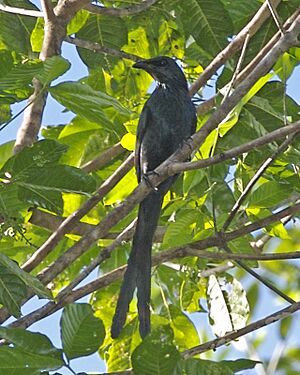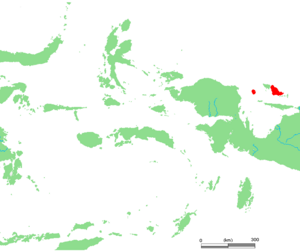Long-tailed starling facts for kids
Quick facts for kids Long-tailed starling |
|
|---|---|
 |
|
| Conservation status | |
| Scientific classification | |
| Genus: |
Aplonis
|
| Species: |
magna
|
 |
|
| Global range (In red) | |
The long-tailed starling (Aplonis magna) is a type of starling bird. It belongs to the Sturnidae family. This bird is special because it is only found on the Schouten Islands. These islands are off the coast of West Papua, in Indonesia. This area is very important for unique birds.
There are two main types, or subspecies, of the long-tailed starling. The first type lives on Biak Island. The second type, called brevicauda, lives on Numfor Island. These birds live in many different places, from natural forests to gardens and forests changed by people. Even though they live in a small area, they are not in danger. They are quite common, so the IUCN lists them as "least concern."
What Does It Look Like?
The long-tailed starling is a big bird. It can be from 28 to 41 centimeters (about 11 to 16 inches) long. This measurement includes its very long tail! Male and female long-tailed starlings look the same.
The tail is a key feature. For the main type of starling, the tail can be as long as or even longer than its body. But for the brevicauda type, the tail is only about two-thirds the length of its body. When in the wild, these birds often lift and spread their large tails.
Their feathers are black. They have a shiny, oily green look over their body. The brevicauda type is a bit less shiny. The feathers on their head have a bronze shine. The feathers on their forehead are stiff and spiky. Their feet and beak are black, and their eyes are brown.
Behavior and Calls
We don't know a lot about how these birds live. However, they are easy to spot. They often sit on high, open branches in trees. They look a bit like a drongo when they do this.
Their calls are loud and musical. People describe them as a series of loud warbles. They also make a sliding "cheeeuw" sound that goes down in pitch. Long-tailed starlings usually live in small groups or in pairs. They look for fruit in trees and in the plants on the ground.
Life Cycle
We know very little about how these birds raise their young. The only thing we know for sure is that they build their nests high up in trees.


